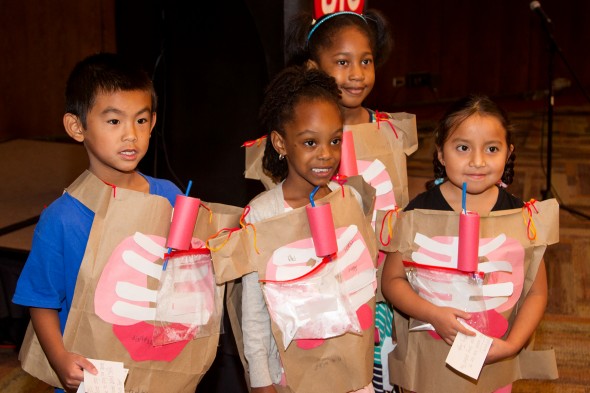Early outreach program nurtures interest in health sciences

Students in UIC’s Urban Health Early Outreach and Health Sciences Enrichment Program share what they learned about the human body. (Photo: Vibhu S. Rangavasan)
A group of 110 grade school and high school students developed a new set of skills through UIC’s Urban Health Early Outreach and Health Sciences Enrichment Program.
The program, which is part of the UIC Office of Diversity of Inclusion’s Urban Health Program, develops young students’ skills in science and research to prepare them for college and for careers in health and medicine.
“Too many students are unprepared for college when they graduate,” said Joy Valentine, director of the Early Outreach Program. Valentine said that less than half of students in the area immediately surrounding UIC are college-ready after high school.
“Our goal is to help students easily move into the high schools, universities and post-graduate programs of their choice,” Valentine said.
The program was first established in 1981 and has worked with more than 11,000 students. The majority of students in the program are black (55 percent) and Latino (37 percent). On average, students participate in the program for six years.
“Our focus this year was helping students understand and value collaboration,” Valentine said. “We adopted a project-based approach. We wanted our students to have an opportunity to work in teams to identify solutions because this is how research and problem solving occurs in the ‘real world’ of health sciences professions.”
For six weeks, students studied subjects ranging from computer coding to language arts. Each year, the program has a different health-related theme. This year’s theme was “In Sickness and Health.”
“The theme was selected to draw our student’s attention to topics relevant to health and medicine,” says Vernita Lewis, assistant director of the Early Outreach Program. “We also wanted to make sure students learned how these topics are relevant to their own health and the health of their families.”
At the end of the program, students were asked to prepare a final presentation.
One group of first-grade students who live in the Chicago Metropolitan area — Jayden Aguayo (6), Elisa Briscoe (6), Natalie Butler (6) and Kochiti Holton (7) — stood up in front of the audience of parents and classmates to share what they’ve learned about the human body. Their presentation was a song and dance recital of “The Skeleton Dance.”
A room over, a group of high school students — Joi Brown (16; Monee, Illinois), Nana Duku (16; Homewood, Illinois) and Jordyn Rudder (16; Chicago) — presented research on the potential use of nanoshell gummies as a treatment for childhood medulloblastoma, a type of brain tumor. To illustrate the importance of research in this area, the three students acted out a skit, playing the roles of physician, parent and patient throughout the diagnosis, treatment and (potential) cure of cancer.
“We decided to research cancer because a lot of people are affected by it,” said Rudder, a junior at Kenwood Academy. “When my grandma was going through chemo, it was terrible. With this project we researched another treatment for cancer.”
Brown, a junior at Marian Catholic High School, said her experience in the early outreach program opened her eyes to new things. “Every day we had classes on biology, health or math,” she said. “I want to be in the medical field — this helped me understand something new.”
Duku, a sophomore at Flossmoor High School, said she was happy for the exposure as well. “It was a fun experience,” she said.
As of last spring, the college acceptance rate and the college attendance rate of students in the program are 100 percent.
